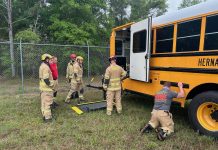Fairfax County Public Schools has a long history of promoting excellence in school bus driver training to both prepare and keep our drivers ready for their duties. Due to our size and turnover, we train over 100 new drivers annually.
Recently, our bus training center was moved from a renovated shop classroom that was subdivided at a local high school to a newer location that better provides for our instructional needs.
With the advantage of more space at our new location, we have added some additional training aids in the classrooms to make the learning experience both easier and more enjoyable. One of these areas is the Special Needs Classroom. In the rear of the classroom is a school bus… well, part of one anyway.
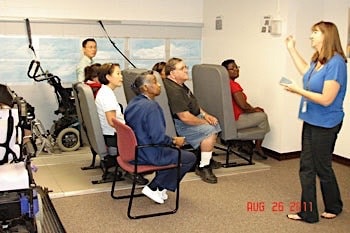 We have a “mock” section of flooring complete with tracking for wheelchairs and bus seats. This allows both new trainees and established drivers/attendants to have hands-on experience securing car seats and wheelchairs in the bus, and securing passengers (using various youth-size dolls or classmates) in car seats and wheelchairs. There is even tracking along the wall to practice securing the shoulder belt on a wheelchair passenger.
We have a “mock” section of flooring complete with tracking for wheelchairs and bus seats. This allows both new trainees and established drivers/attendants to have hands-on experience securing car seats and wheelchairs in the bus, and securing passengers (using various youth-size dolls or classmates) in car seats and wheelchairs. There is even tracking along the wall to practice securing the shoulder belt on a wheelchair passenger.
This allows not only practice, but also affords a much better vantage point to observe the instructor or others demonstrate or practice the processes. It’s hard to see through the sides of a normal bus…This one is open for the eyes and allows class participants to get closer to the action. We now have several different types of bus seats (some with 2-point belts, 3-point belts, and some with integrated systems) and we have several different types of wheelchairs (electric and manual) to help understand how and where attachments should be made.
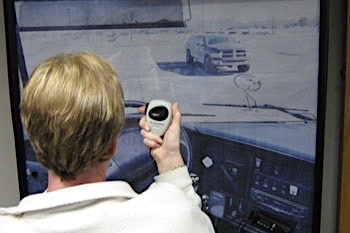 Another training area is for radio practice. We now have a dedicated room with four stations that simulate being in the driver’s seat. Each station has fully functioning radios located right where they would be on an actual bus. These stations also include the real ignition switches, emergency buttons, microphones, etc., in the same locations as the actual buses. This brings more realism to the learning experience and allows four trainees to practice radio drills at the same time.
Another training area is for radio practice. We now have a dedicated room with four stations that simulate being in the driver’s seat. Each station has fully functioning radios located right where they would be on an actual bus. These stations also include the real ignition switches, emergency buttons, microphones, etc., in the same locations as the actual buses. This brings more realism to the learning experience and allows four trainees to practice radio drills at the same time.
More realism and practice in the classroom translates into more effective training, better understanding of equipment and procedures and fewer problems in the real world for our drivers and attendants. Each driver trainee practices more than 20 different radio scenarios while in various phases of training to acquaint themselves with procedures and emergency protocols as well as make them more comfortable in using and responding to the two-way radio while out on the road.
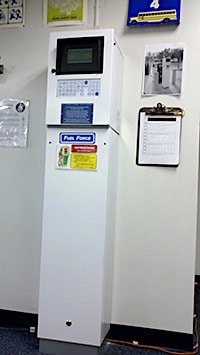 We now a have an actual working FUELFORCE, or automated fueling system terminal, in the classroom. This allows students to practice how to login, report the vehicle number and mileage and do everything except dispense fuel. This system provides experience and early exposure for new drivers on how bad odometer readings, or a bad entry of an odometer or vehicle number, can prevent proper access to the system, as well as some other common mistakes our drivers encounter from time to time. This will help them to avoid mistakes or at least know how to correct their information errors and fix the problems.
We now a have an actual working FUELFORCE, or automated fueling system terminal, in the classroom. This allows students to practice how to login, report the vehicle number and mileage and do everything except dispense fuel. This system provides experience and early exposure for new drivers on how bad odometer readings, or a bad entry of an odometer or vehicle number, can prevent proper access to the system, as well as some other common mistakes our drivers encounter from time to time. This will help them to avoid mistakes or at least know how to correct their information errors and fix the problems.
We also have a “heat rail” or plug-in with a “ground fault” in the classroom for practice. We use these at several bus lots to plug in our buses and keep the engine warm during cold weather. Recognizing when the “ground fault” has tripped and how to reset it is easy to do once you understand what to look for and how to do it. Being able to see it, touch it and not just hear about it makes a world of difference for understanding and retaining the knowledge.
How do the lights, doors, stop arm, crossing gate, interlocks, hatches, doors, and child check systems work? It used to be that we would try to describe them in class, and even show pictures to try and help new drivers understand. But, usually it wasn’t until they actually got out on a bus and were able to interact with these parts and sounds that it actually began to come together in their minds.
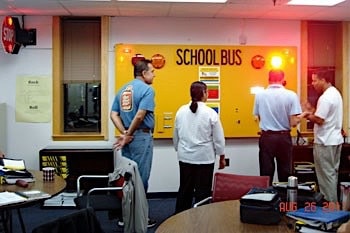 Now new drivers can actually see and practice how these work in the classroom as we first introduce the concepts. They can hear the buzzers, horns and alarms that come on to alert them (and, yes, we have muffled the sounds to avoid driving everyone in the building crazy) when something is not just right. They can experiment with figuring out which component is still locked and if that is why the bus will not start.
Now new drivers can actually see and practice how these work in the classroom as we first introduce the concepts. They can hear the buzzers, horns and alarms that come on to alert them (and, yes, we have muffled the sounds to avoid driving everyone in the building crazy) when something is not just right. They can experiment with figuring out which component is still locked and if that is why the bus will not start.
They can see it all on one board, at one time, and actually practice what changes cause or fix problems. They can also practice disarming the child check system or find out what happens when it isn’t done fast enough. All of these things sound simple to those of us who use them every day, but it can be overwhelming when new drivers are just beginning to learn about a school bus.
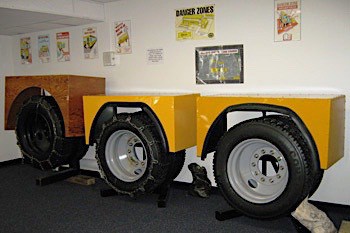 We have had one station to practice installation of tire chains inside the classroom for many years, but it was always a bottleneck while everyone waited to get a turn. It was also an obstruction in a crowded classroom when it was not being used. Now that we have more space, we had our buddies at the garage make us two more stations, which allow three people to practice at the same time.
We have had one station to practice installation of tire chains inside the classroom for many years, but it was always a bottleneck while everyone waited to get a turn. It was also an obstruction in a crowded classroom when it was not being used. Now that we have more space, we had our buddies at the garage make us two more stations, which allow three people to practice at the same time.
In our area, we would not open school in the morning with weather conditions requiring the use of tire chains, but weather forecasts can be wrong or conditions can change. More likely, buses can get delayed in traffic for lengthy periods and conditions can worsen; so, having and knowing how to use tire chains can help get our buses safely home. It is much easier and cleaner to practice in the classroom than outside.
We have a mirror grid next to our facility and a cone course just a few blocks away. The mirror grid is a valuable tool for teaching proper mirror adjustment and on the cone course new drivers can practice skills development before venturing out onto the roadways. This has been especially helpful in practicing the use of mirrors, parallel parking, and backing.
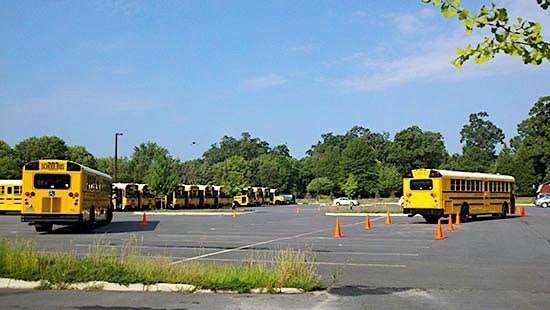 Other drills include diminished clearance, right turn, and serpentine (in both directions). We have always tried to find space at a local park, but having own space is advantageous. We are looking at how we might utilize these drills for in-service purposes as well.
Other drills include diminished clearance, right turn, and serpentine (in both directions). We have always tried to find space at a local park, but having own space is advantageous. We are looking at how we might utilize these drills for in-service purposes as well.
Each of our new trainees gets to experience escaping through a roof hatch on a real bus. We saved an old bus and turned it onto its side for this purpose. The preparation for the feeling of disorientation from inside the bus, moving from the rear door to the front in the area that is normally the ceiling, and the feeling of accomplishment after you get yourself out are priceless. The exposed underside of the bus also gives new trainees a perspective of those components that they would not normally see.
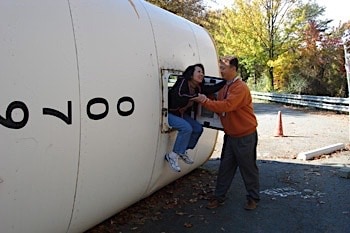 Use of mannequins and dolls in the class can be an effective tool. With more space, we now have additional CPR and defibrillator manikins to allow more individual practice time for CPR skills and/or other student health emergency drills. Each new driver and attendant is certified in CPR and student health emergencies and is required to return every two years for a recertification class.
Use of mannequins and dolls in the class can be an effective tool. With more space, we now have additional CPR and defibrillator manikins to allow more individual practice time for CPR skills and/or other student health emergency drills. Each new driver and attendant is certified in CPR and student health emergencies and is required to return every two years for a recertification class.
Each new driver receives approximately 56 hours of classroom materials and a minimum of 24 hours of BTW. This is followed by a week of large bus and another week of small bus OJT before final certification as a driver; however, continued training is an ongoing goal. Drivers participate in regular team meetings and in-service meetings each year to maintain their certification, and every five years they return for a few days of classroom and BTW recertification instruction at the training center.
Drivers and attendants who have preventable accidents return to the training center for Driver Improvement Classes. In addition, our trainers support our supervisors in performing ride-alongs (RALs) to observe driver performance on runs, and are regularly asked to assess, and to develop specific training to address, an individual driver’s or attendant’s needs when necessary. Our goal is to help individuals continue to meet requirements, but occasionally, through this ride-along program, we are the ones to help identify poor, degrading or recurring performance issues that lead to separation.
We always strive to produce high quality drivers and like to believe that not only have we been successful, but that we also help our drivers and attendants to succeed. We are proud that we have a Training Center that helps us to better promote that same image of quality.
Tim Parker is the assistant director of transportation services for Fairfax County Public Schools in Lorton, Va. He can be reached at tparker@fcps.edu.













